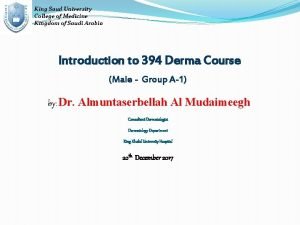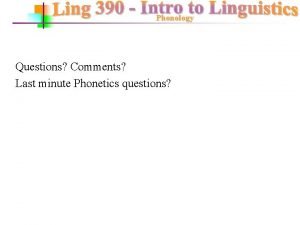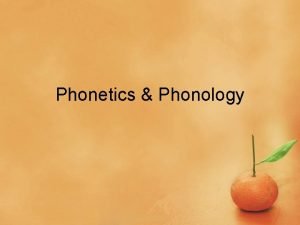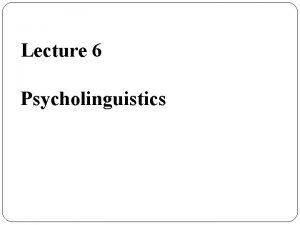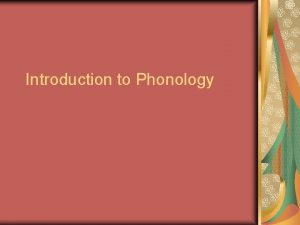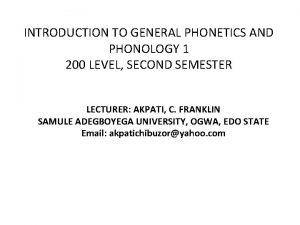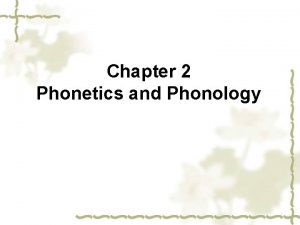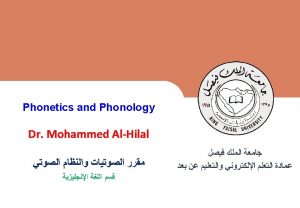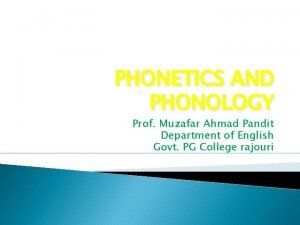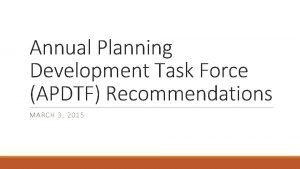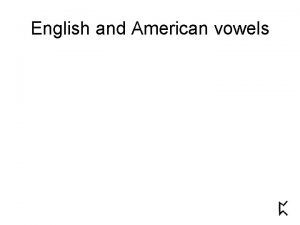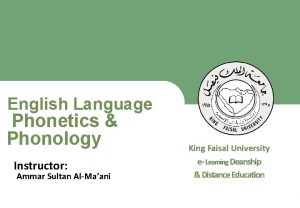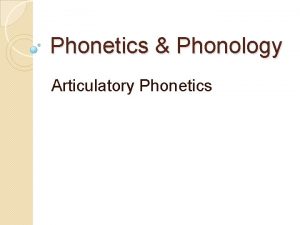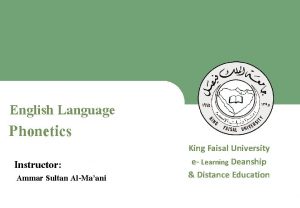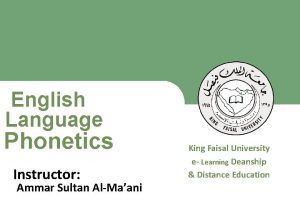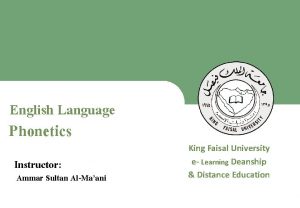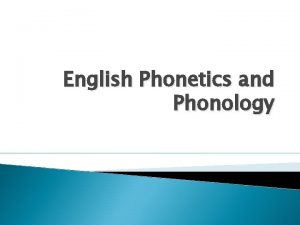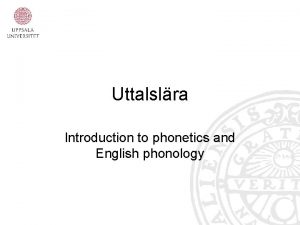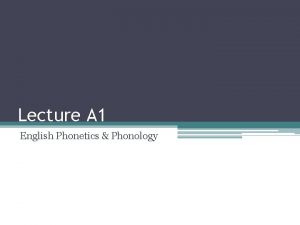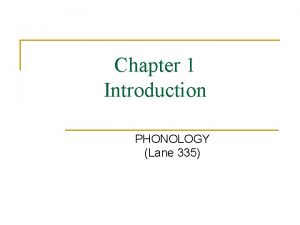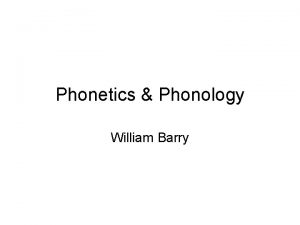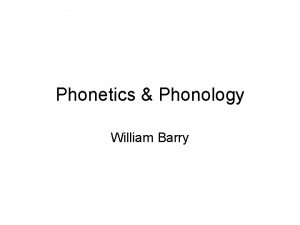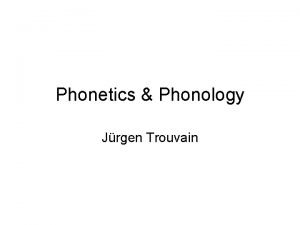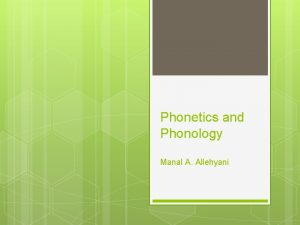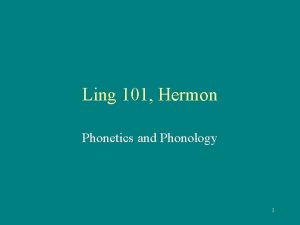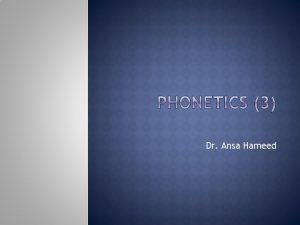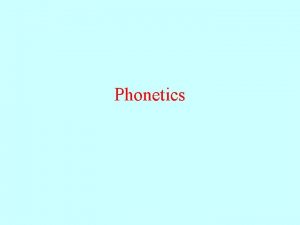English Language Phonetics Phonology King Faisal University e















![Liquids and nasals as syllable nuclei • The English liquids [ r l ] Liquids and nasals as syllable nuclei • The English liquids [ r l ]](https://slidetodoc.com/presentation_image_h/82002f896e141bfeb41d953879f89a30/image-16.jpg)









- Slides: 25

English Language Phonetics & Phonology King Faisal University e- Learning Deanship & Distance Education Instructor: Ammar Sultan Al-Ma’ani ﻋﻤﺎﺩﺓ ﺍﻟﺘﻌﻠﻢ ﺍﻹﻟﻜﺘﺮﻭﻧﻲ ﻭﺍﻟﺘﻌﻠﻴﻢ ﻋﻦ ﺑﻌﺪ 1 Deanship of E-Learning and Distance Education [ ] 11 ﺟﺎﻣﻌﺔ ﺍﻟﻤﻠﻚ ﻓﻴﺼﻞ King Faisal University

7 th Class Syllable Structure in English Lets study it… ﻋﻤﺎﺩﺓ ﺍﻟﺘﻌﻠﻢ ﺍﻹﻟﻜﺘﺮﻭﻧﻲ ﻭﺍﻟﺘﻌﻠﻴﻢ ﻋﻦ ﺑﻌﺪ Deanship of E-Learning and Distance Education [ ] 2 ﺟﺎﻣﻌﺔ ﺍﻟﻤﻠﻚ ﻓﻴﺼﻞ King Faisal University

What Does Syllabification of a Word Mean? - Words can be cut up into units called syllables. - Humans seem to need syllables as a way of segmenting the stream of speech and giving it a rhythm of strong and weak beats, as we hear in Music. - Syllables exist only to make speech easier for the brain to process. - A word contains at least one syllable. ﻋﻤﺎﺩﺓ ﺍﻟﺘﻌﻠﻢ ﺍﻹﻟﻜﺘﺮﻭﻧﻲ ﻭﺍﻟﺘﻌﻠﻴﻢ ﻋﻦ ﺑﻌﺪ Deanship of E-Learning and Distance Education [ ] 3 ﺟﺎﻣﻌﺔ ﺍﻟﻤﻠﻚ ﻓﻴﺼﻞ King Faisal University

Most speakers of English … …have no trouble dividing a word up into its component syllables. Sometimes how a particular word is divided might vary from one individual to another, but a division is always easy and always possible. Here are some words divided into their component syllables (a period is used to mark the end of a syllable): tomato = to. ma. to window = win. dow (some people might put some of the periods in different places in this word). ﻋﻤﺎﺩﺓ ﺍﻟﺘﻌﻠﻢ ﺍﻹﻟﻜﺘﺮﻭﻧﻲ ﻭﺍﻟﺘﻌﻠﻴﻢ ﻋﻦ ﺑﻌﺪ Deanship of E-Learning and Distance Education [ ] 4 ﺟﺎﻣﻌﺔ ﺍﻟﻤﻠﻚ ﻓﻴﺼﻞ King Faisal University

Syllables and their parts • The parts are onset and rhyme; within the rhyme we find the nucleus and coda. • Not all syllables have all parts; the smallest possible syllable contains a nucleus only. * A syllable may or may not have an onset and a coda. ﻋﻤﺎﺩﺓ ﺍﻟﺘﻌﻠﻢ ﺍﻹﻟﻜﺘﺮﻭﻧﻲ ﻭﺍﻟﺘﻌﻠﻴﻢ ﻋﻦ ﺑﻌﺪ Deanship of E-Learning and Distance Education [ ] 5 ﺟﺎﻣﻌﺔ ﺍﻟﻤﻠﻚ ﻓﻴﺼﻞ King Faisal University

Onset (O) Onset: the beginning sounds of the syllable; the ones preceding the nucleus. These are always consonants in English. The nucleus is a vowel in most cases, although the consonants [ r ], [ l ], [ m ], [ n ], and the velar nasal (the 'ng' sound) can also be the nucleus of a syllable. In the following words, the onset is in bold; the rest underlined. read flop strap ﻋﻤﺎﺩﺓ ﺍﻟﺘﻌﻠﻢ ﺍﻹﻟﻜﺘﺮﻭﻧﻲ ﻭﺍﻟﺘﻌﻠﻴﻢ ﻋﻦ ﺑﻌﺪ Deanship of E-Learning and Distance Education [ ] 6 ﺟﺎﻣﻌﺔ ﺍﻟﻤﻠﻚ ﻓﻴﺼﻞ King Faisal University

If a word contains more than one syllable, each syllable will have the usual syllable parts: win. dow to. ma. to pre. pos. te. rous fun. da. men. tal ﻋﻤﺎﺩﺓ ﺍﻟﺘﻌﻠﻢ ﺍﻹﻟﻜﺘﺮﻭﻧﻲ ﻭﺍﻟﺘﻌﻠﻴﻢ ﻋﻦ ﺑﻌﺪ Deanship of E-Learning and Distance Education [ ] 7 ﺟﺎﻣﻌﺔ ﺍﻟﻤﻠﻚ ﻓﻴﺼﻞ King Faisal University

Rhyme (R) Rhyme (or rime): the rest of the syllable, after the onset (the underlined portions of the words above). The rhyme can also be divided up: Rhyme = nucleus + coda ﻋﻤﺎﺩﺓ ﺍﻟﺘﻌﻠﻢ ﺍﻹﻟﻜﺘﺮﻭﻧﻲ ﻭﺍﻟﺘﻌﻠﻴﻢ ﻋﻦ ﺑﻌﺪ Deanship of E-Learning and Distance Education [ ] 8 ﺟﺎﻣﻌﺔ ﺍﻟﻤﻠﻚ ﻓﻴﺼﻞ King Faisal University

Nucleus (N) • Nucleus is the core or essential part of a syllable. A nucleus must be present in order for a syllable to be present. * In English and most other languages, most syllable nuclei are vowels. * The English liquids [ r l ] and the nasals [ m n ] can be the nuclei of syllables under certain conditions. [ r ] can be a nucleus as easily as a vowel, in any position: the words 'bird', have [ r ] as the nucleus; in other words, there is no vowel in the pronunciation of these syllables, even though they have one in the spelling. [brd] [ l ] and the nasals [ m n ] become syllable nuclei when they follow an alveolar consonant in the last syllable of a word. This happens in the relaxed or casual rather than very formal articulation of the word. Compare casual vs. formal pronunciations of 'button', 'bottle', 'bottom'. ﻋﻤﺎﺩﺓ ﺍﻟﺘﻌﻠﻢ ﺍﻹﻟﻜﺘﺮﻭﻧﻲ ﻭﺍﻟﺘﻌﻠﻴﻢ ﻋﻦ ﺑﻌﺪ Deanship of E-Learning and Distance Education [ ] 9 ﺟﺎﻣﻌﺔ ﺍﻟﻤﻠﻚ ﻓﻴﺼﻞ King Faisal University

The Core Syllable The core syllable is made up of a Nucleus preceded by an Onset: O(nset) N(ucleus) C ﻋﻤﺎﺩﺓ ﺍﻟﺘﻌﻠﻢ ﺍﻹﻟﻜﺘﺮﻭﻧﻲ ﻭﺍﻟﺘﻌﻠﻴﻢ ﻋﻦ ﺑﻌﺪ Deanship of E-Learning and Distance Education V [ ] 10 ﺟﺎﻣﻌﺔ ﺍﻟﻤﻠﻚ ﻓﻴﺼﻞ King Faisal University

The Core Syllable - Some languages only have CV syllables. - More commonly, languages allow for syllables of greater complexity. - The core syllable is, however, found in every language. - The fact that CV syllables are cross-linguistically attested offers an interesting parallel with their invariable occurrence in early child language. ﻋﻤﺎﺩﺓ ﺍﻟﺘﻌﻠﻢ ﺍﻹﻟﻜﺘﺮﻭﻧﻲ ﻭﺍﻟﺘﻌﻠﻴﻢ ﻋﻦ ﺑﻌﺪ Deanship of E-Learning and Distance Education [ ] 11 ﺟﺎﻣﻌﺔ ﺍﻟﻤﻠﻚ ﻓﻴﺼﻞ King Faisal University

* Linguists often use tree diagrams to illustrate syllable structure. 'Flop', for example, would look like this (the word appears in IPA symbols, not English spelling). 's' = 'syllable'; 'O' = 'onset'; 'R' = 'rhyme'; 'N' = 'nucleus'; 'C' = 'coda'. • The syllable node at the top of the tree branches into Onset and Rhyme; the Onset node branches because it contains two consonants, [ f ] and [ l ]. The Rhyme node branches because this syllable has both a nucleus and a coda. σ / O R / | | N C | | [ f l a p ] ﻋﻤﺎﺩﺓ ﺍﻟﺘﻌﻠﻢ ﺍﻹﻟﻜﺘﺮﻭﻧﻲ ﻭﺍﻟﺘﻌﻠﻴﻢ ﻋﻦ ﺑﻌﺪ Deanship of E-Learning and Distance Education [ ] 12 ﺟﺎﻣﻌﺔ ﺍﻟﻤﻠﻚ ﻓﻴﺼﻞ King Faisal University

Steps to determine the diagram: a. Determine the nucleus (N) b. Add Rhyme ( R ) on the ordinate of the nucleus c. Determine the onset (O) and the coda (C). ﻋﻤﺎﺩﺓ ﺍﻟﺘﻌﻠﻢ ﺍﻹﻟﻜﺘﺮﻭﻧﻲ ﻭﺍﻟﺘﻌﻠﻴﻢ ﻋﻦ ﺑﻌﺪ Deanship of E-Learning and Distance Education [ ] 13 ﺟﺎﻣﻌﺔ ﺍﻟﻤﻠﻚ ﻓﻴﺼﻞ King Faisal University

The syllable structure analysis of the words 'read', 'flop', 'strap' and 'window' are as follows (IPA symbols are used to show the sounds in the word/syllable): read = one syllable Onset = [ r ] Rhyme = [ id ] (within the rhyme: ) Nucleus = [ i ] Coda = [ d ] flop = one syllable Onset = [ f l ] Rhyme = [ a p ] Nucleus = [ a ] Coda = [ p ] ﻋﻤﺎﺩﺓ ﺍﻟﺘﻌﻠﻢ ﺍﻹﻟﻜﺘﺮﻭﻧﻲ ﻭﺍﻟﺘﻌﻠﻴﻢ ﻋﻦ ﺑﻌﺪ Deanship of E-Learning and Distance Education window = 2 syllables First syllable: [w. In] Onset = [ w ] Rhyme = [ I n ] Nucleus = [ I ] Coda = [ n ] Second syllable: [ d o ] Onset = [ d ] Rhyme = [ o ] Nucleus = [ o ] (This syllable has no coda) [ ] 14 ﺟﺎﻣﻌﺔ ﺍﻟﻤﻠﻚ ﻓﻴﺼﻞ King Faisal University

Notice a. If a syllable has the coda, it is called as closed syllable Example : cap, sit, man b. If a syllable doesn’t have the coda it is called as open syllable. Example : he, she, me ﻋﻤﺎﺩﺓ ﺍﻟﺘﻌﻠﻢ ﺍﻹﻟﻜﺘﺮﻭﻧﻲ ﻭﺍﻟﺘﻌﻠﻴﻢ ﻋﻦ ﺑﻌﺪ Deanship of E-Learning and Distance Education [ ] 15 ﺟﺎﻣﻌﺔ ﺍﻟﻤﻠﻚ ﻓﻴﺼﻞ King Faisal University
![Liquids and nasals as syllable nuclei The English liquids r l Liquids and nasals as syllable nuclei • The English liquids [ r l ]](https://slidetodoc.com/presentation_image_h/82002f896e141bfeb41d953879f89a30/image-16.jpg)
Liquids and nasals as syllable nuclei • The English liquids [ r l ] and the nasals [ m n ] can be the nuclei of syllables under certain conditions. [ r ] can be a nucleus as easily as a vowel, in any position: the words 'bird', 'word', 'her', 'fur', the first syllable of 'perceive' and 'surname' and the final syllables of 'mother', 'actor' (in casual pronunciation) all have [ r ] as the nucleus; in other words, there is no vowel in the pronunciation of these syllables, even though they have one in the spelling. • [ l ] and the nasals [ m n ] become syllable nuclei when they follow an alveolar consonant in the last syllable of a word. This happens in the relaxed or casual rather than very formal articulation of the word. Compare casual vs. formal pronunciations of 'button', 'bottle', 'bottom'. • When one of these sounds is a syllable nucleus, this is shown in transcription by putting a very short vertical line under the IPA symbol [ r l m n ]. ' ' ﻋﻤﺎﺩﺓ ﺍﻟﺘﻌﻠﻢ ﺍﻹﻟﻜﺘﺮﻭﻧﻲ ﻭﺍﻟﺘﻌﻠﻴﻢ ﻋﻦ ﺑﻌﺪ Deanship of E-Learning and Distance Education [ ] 16 ﺟﺎﻣﻌﺔ ﺍﻟﻤﻠﻚ ﻓﻴﺼﻞ King Faisal University

Summary of the elements of a phonological system… The phonological system of a language includes various units plus patterns which are used to combine the units into larger units. The units of a phonological system are: 1. features: aspects or characteristics of a speech sound that arise from the way the sound is articulated or the way it sounds to the ear. 'Voicing' is a feature that varies according to whether or not the vocal cords vibrate during the articulation of a sound; the sound [ s ] is voiceless, but the sound [ z ] is voiced, for example. Other features include 'manner', or what sort of gesture or position is used to make a consonant sound (a 'stop' involves blocking the airstream completely for a fraction of a second, as for [ p ], while a 'fricative' involves creating a narrow opening through which air escapes, as for [ f ]. There also suprasegmental features, which are 'overlaid' on syllables or words. One such feature is stress, known outside linguistics as 'where the accent is in a word'. In 'potato', the stress falls on the second syllable; in 'promise' on the first. ﻋﻤﺎﺩﺓ ﺍﻟﺘﻌﻠﻢ ﺍﻹﻟﻜﺘﺮﻭﻧﻲ ﻭﺍﻟﺘﻌﻠﻴﻢ ﻋﻦ ﺑﻌﺪ Deanship of E-Learning and Distance Education [ ] 17 ﺟﺎﻣﻌﺔ ﺍﻟﻤﻠﻚ ﻓﻴﺼﻞ King Faisal University

Summary of the elements of a phonological system 2. segments: a segment is a speech sound such as [ m ] or [ i ]. Speech sounds are made by putting several features together. [ m ], for example, is created by vibrating the vocal cords (feature: voiced), closing the mouth at the lips (feature: bilabial), and lowering the soft palate so that air can escape through the nose (feature: nasal). These three gestures occur simultaneously. The result is a voiced bilabial nasal, [ m ]. Thus, segments are units that are built up from features; features are the building blocks for segments. ﻋﻤﺎﺩﺓ ﺍﻟﺘﻌﻠﻢ ﺍﻹﻟﻜﺘﺮﻭﻧﻲ ﻭﺍﻟﺘﻌﻠﻴﻢ ﻋﻦ ﺑﻌﺪ Deanship of E-Learning and Distance Education [ ] 18 ﺟﺎﻣﻌﺔ ﺍﻟﻤﻠﻚ ﻓﻴﺼﻞ King Faisal University

3. syllables: a syllable is a rhythmic unit of speech. Syllables exist to make the speech stream easier for the human mind to process. A syllable comprises one or more segments; segments are the building blocks for syllables. Details on the syllable are found below. ﻋﻤﺎﺩﺓ ﺍﻟﺘﻌﻠﻢ ﺍﻹﻟﻜﺘﺮﻭﻧﻲ ﻭﺍﻟﺘﻌﻠﻴﻢ ﻋﻦ ﺑﻌﺪ Deanship of E-Learning and Distance Education [ ] 19 ﺟﺎﻣﻌﺔ ﺍﻟﻤﻠﻚ ﻓﻴﺼﻞ King Faisal University

4. words: words are made of syllables. ﻋﻤﺎﺩﺓ ﺍﻟﺘﻌﻠﻢ ﺍﻹﻟﻜﺘﺮﻭﻧﻲ ﻭﺍﻟﺘﻌﻠﻴﻢ ﻋﻦ ﺑﻌﺪ Deanship of E-Learning and Distance Education [ ] 20 ﺟﺎﻣﻌﺔ ﺍﻟﻤﻠﻚ ﻓﻴﺼﻞ King Faisal University

The patterns or rule systems of a phonological system include: 1. phonotactics, also known as sequence constraints. These are restrictions on the number and type of segments that can combine to form syllables and words; they vary greatly from one language to another. In English, for example, a word may begin with up to three consonants, but no more than three. If a word does begin with three consonants, the first will always be [ s ], the second must be chosen from among the voiceless stops [ p t k ] and the third from among the liquids [ l r ] or glides [ w y ]. Thus we get words such as 'squeeze' [ s k w i z ] in English, but not words such as [ p s t a p ]. ﻋﻤﺎﺩﺓ ﺍﻟﺘﻌﻠﻢ ﺍﻹﻟﻜﺘﺮﻭﻧﻲ ﻭﺍﻟﺘﻌﻠﻴﻢ ﻋﻦ ﺑﻌﺪ Deanship of E-Learning and Distance Education [ ] 21 ﺟﺎﻣﻌﺔ ﺍﻟﻤﻠﻚ ﻓﻴﺼﻞ King Faisal University

2. phonological processes, including coarticulation processes, are modifications of the feature structure of a sound that occur for one of two reasons: to make sounds that are near each other more alike, thus make articulation easier (assimilation), or to make sounds more different from each other (for instance, aspiration makes voiceless stops such as [ p ] and [ k ] more different from voiced ones such as [ b ] and [ g ]. ﻋﻤﺎﺩﺓ ﺍﻟﺘﻌﻠﻢ ﺍﻹﻟﻜﺘﺮﻭﻧﻲ ﻭﺍﻟﺘﻌﻠﻴﻢ ﻋﻦ ﺑﻌﺪ Deanship of E-Learning and Distance Education [ ] 22 ﺟﺎﻣﻌﺔ ﺍﻟﻤﻠﻚ ﻓﻴﺼﻞ King Faisal University

Draw, the syllable structure of the following words: apron basic began begin depend even hotel ﻋﻤﺎﺩﺓ ﺍﻟﺘﻌﻠﻢ ﺍﻹﻟﻜﺘﺮﻭﻧﻲ ﻭﺍﻟﺘﻌﻠﻴﻢ ﻋﻦ ﺑﻌﺪ Deanship of E-Learning and Distance Education [ ] 23 ﺟﺎﻣﻌﺔ ﺍﻟﻤﻠﻚ ﻓﻴﺼﻞ King Faisal University

Exercise: Analyzing the syllable structure of English words Using the models on the 'Syllable structure in English' page for the words 'read', 'flop', and 'window', analyze the following words into their syllable structure. (See Slide 14) (1) Write the word with periods between the syllables; use IPA symbols - Ex. 'baby' = [ be. bi ] (2) List and identify the parts of each syllable Remember that diphthongs count as single vowel segments. Here are your words: (1) playdough (2) thanks (3) nondescript (take your time!) (4) toys (5) straw (6) plastic Ex. : 'boondocks' = [ bun. daks ] First syllable: [ bun ] Onset [ b ] Rhyme [ un ] Nucleus [ u ] Coda [ n ] Second syllable: [ daks ] Onset [ d ] Rhyme [ aks ] Nucleus [ a ] Coda [ ks ] ﻋﻤﺎﺩﺓ ﺍﻟﺘﻌﻠﻢ ﺍﻹﻟﻜﺘﺮﻭﻧﻲ ﻭﺍﻟﺘﻌﻠﻴﻢ ﻋﻦ ﺑﻌﺪ Deanship of E-Learning and Distance Education [ ] 24 ﺟﺎﻣﻌﺔ ﺍﻟﻤﻠﻚ ﻓﻴﺼﻞ King Faisal University

 King faisal university college of medicine
King faisal university college of medicine Phonetics speech sounds
Phonetics speech sounds Difference between phonetics and phonology
Difference between phonetics and phonology Manner of articulation
Manner of articulation Phonetics vs phonology
Phonetics vs phonology Phonetics and phonology
Phonetics and phonology A concise introduction to linguistics answer key
A concise introduction to linguistics answer key Difference between phonetics and phonology
Difference between phonetics and phonology Difference between phonetics and phonology
Difference between phonetics and phonology Introduction to general phonetics and phonology
Introduction to general phonetics and phonology Phonetics vs phonology
Phonetics vs phonology Phonemes and symbols
Phonemes and symbols Secondary vowels
Secondary vowels Phonetics and phonology
Phonetics and phonology King abdulaziz university english language institute
King abdulaziz university english language institute Epcardium
Epcardium Dr ahmad faisal
Dr ahmad faisal Uch sharif mazar
Uch sharif mazar Math 102 kfupm
Math 102 kfupm Faisal jaswal
Faisal jaswal Faisal ali mousa
Faisal ali mousa Behavioural adaptations of a cheetah
Behavioural adaptations of a cheetah Said faisal aha centre
Said faisal aha centre Faisal hd
Faisal hd Phonology examples in english
Phonology examples in english American english phonology
American english phonology
